
Releases from NASA, HubbleSite, Spitzer, ESO, ESA, NASA’s Chandra X-ray Observatory, Royal Astronomical Society, Harvard-Smithsonian Center For Astrophysics, Max Planck Institute, Gemini Observatory, Subaru Telescope, W. M. Keck Observatory, JPL-Caltech, ICRAR, Webb Space Telescope, etc
Wednesday, April 30, 2008
The Second Stellar Baby Boom

Tuesday, April 29, 2008
Compact Galaxies in Early Universe Pack a Big Punch
 Credit: NASA, ESA, P. van Dokkum (Yale University), M. Franx (Leiden University, The Netherlands), and G. Illingworth (University of California, Santa Cruz, and Lick Observatory)
Credit: NASA, ESA, P. van Dokkum (Yale University), M. Franx (Leiden University, The Netherlands), and G. Illingworth (University of California, Santa Cruz, and Lick Observatory)Imagine receiving an announcement touting the birth of a baby 20 inches long and weighing 180 pounds. After reading this puzzling message, you would immediately think the baby's weight was a misprint.
Astronomers looking at galaxies in the universe's distant past received a similar perplexing announcement when they found nine young, compact galaxies, each weighing in at 200 billion times the mass of the Sun. The galaxies, each only 5,000 light-years across, are a fraction of the size of today's grownup galaxies but contain approximately the same number of stars. Each galaxy could fit inside the central hub of our Milky Way Galaxy.
Astronomers used NASA's Hubble Space Telescope and the W.M. Keck Observatory on Mauna Kea, Hawaii, to study the galaxies as they existed 11 billion years ago, when the universe was less than 3 billion years old.
"Seeing the compact sizes of these galaxies is a puzzle," said Pieter G. van Dokkum of Yale University in New Haven, Conn., who led the study. "No massive galaxy at this distance has ever been observed to be so compact. It is not yet clear how they would build themselves up to become the large galaxies we see today. They would have to change a lot over 11 billion years, growing five times bigger. They could get larger by colliding with other galaxies, but such collisions may not be the complete answer."
To determine the sizes of the galaxies, the team used the Near Infrared Camera and Multi-Object Spectrometer on Hubble. The Keck observations were carried out with assistance of a powerful laser to correct for image blurring caused by the Earth's atmosphere. "Only Hubble and Keck can see the sizes of these galaxies because they are very small and far away," van Dokkum explained.
Van Dokkum and his colleagues studied the galaxies in 2006 with the Gemini South Telescope Near-Infrared Spectrograph, on Cerro Pachon in the Chilean Andes. Those observations provided the galaxies' distances and showed that the stars are a half a billion to a billion years old. The most massive stars had already exploded as supernovae.
"In the Hubble Deep Field, astronomers found that star-forming galaxies are small," said Marijn Franx of Leiden University, The Netherlands. "However, these galaxies were also very low in mass. They weigh much less than our Milky Way. Our study, which surveyed a much larger area than in the Hubble Deep Field, surprisingly shows that galaxies with the same weight as our Milky Way were also very small in the past. All galaxies look really different in early times, even massive ones that formed their stars early."
The ultradense galaxies might comprise half of all galaxies of that mass 11 billion years ago, van Dokkum said, forming the building blocks of today's largest galaxies.
How did these small, crowded galaxies form? One way, suggested van Dokkum, involves the interaction of dark matter and hydrogen gas in the nascent universe. Dark matter is an invisible form of matter that accounts for most of the universe's mass. Shortly after the Big Bang, the universe contained an uneven landscape of dark matter. Hydrogen gas became trapped in puddles of the invisible material and began spinning rapidly in dark matter's gravitational whirlpool, forming stars at a furious rate.
Based on the galaxies' masses, which are derived from their color, the astronomers estimated that the stars are spinning around their galactic disks at roughly 890,000 to 1 million miles an hour (400 to 500 kilometers a second). Stars in today's galaxies, by contrast, are traveling at about half that speed because they are larger and rotate more slowly than the compact galaxies.
These galaxies are ideal targets for the Wide Field Camera 3, which is scheduled to be installed aboard Hubble during Servicing Mission 4 in the fall of 2008. "We hope to use the Wide Field Camera 3 to find thousands of these galaxies. The Hubble images, together with the laser adaptive optics at Keck and similar large telescopes, should lead to a better understanding of the evolution of galaxies early in the life of the universe," said Garth Illingworth of the University of California, Santa Cruz, and Lick Observatory.
The findings appeared in the April 10 issue of The Astrophysical Journal Letters.
The authors of the science paper are Pieter van Dokkum (Yale University), Marijn Franx (Leiden University, The Netherlands), Mariska Kriek (Princeton University), Bradford Holden, Garth Illingworth, Daniel Magee, and Rychard Bouwens (University of California, Santa Cruz, and Lick Observatory), Danilo Marchesini (Yale University), Ryan Quadri (Leiden University), Greg Rudnick (National Optical Astronomical Observatory, Tucson), Edward Taylor (Leiden University), and Sune Toft (European Southern Observatory, Germany).
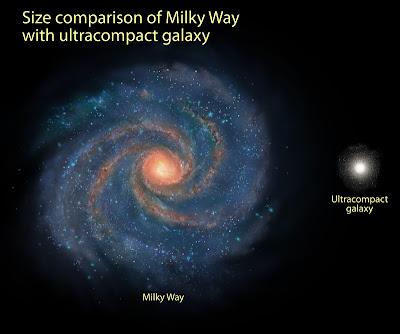 About this Image: This illustration shows the comparative sizes of our Milky Way Galaxy and an ultracompact galaxy, which existed in the early universe. Although the compact galaxy is only a fraction of the size of our Milky Way, it contains the same number of stars. The small, dense galaxy could fit inside the central hub of our Milky Way.
About this Image: This illustration shows the comparative sizes of our Milky Way Galaxy and an ultracompact galaxy, which existed in the early universe. Although the compact galaxy is only a fraction of the size of our Milky Way, it contains the same number of stars. The small, dense galaxy could fit inside the central hub of our Milky Way.Credit: NASA, ESA, A. Feild (STScI), and P. van Dokkum (Yale University)
Monday, April 28, 2008
A Distant Galaxy Cluster - XMMU J2235.3-2557
The composite is made of 4 HAWK-I pointings in both J and Ks and covers 13.5 arc minutes on a side. The cluster is right in the middle of the frame and is difficult to see, given the large field of view, so a blow-up centred on the cluster is shown in the inset. As can be seen by eye, the core of the cluster is dominated by red galaxies with very similar colours. The stars in these galaxies are already very old. On average they formed when the Universe was only one billion years old. As one moves away from the center of the cluster, cluster galaxies become slightly bluer, suggesting that galaxies in the outskirts are either younger or have recently experienced a small amount of star formation (commonly called "frosting"). As one moves even further out, the authors hope to find small groups of galaxies that will, one day, merge with the core.
In the standard flat, lambda-dominated cosmology, the universe is 4.6 billion years old at redshift 1.4 and 1.1 billion years old at redshift 5. The universe at redshift 0 (today) is 13.7 billion years old.
At a redshift of 1.4, 10 arc minutes on the sky corresponds to a linear distance of 5 Mpc (15,000,000,000,000,000,000 km).
Masyuki Tanaka and the HAWK-I science verification team.
ESO - European Organisation
for Astronomical Research in theSouthern Hemisphere
Friday, April 25, 2008
Inside blazars
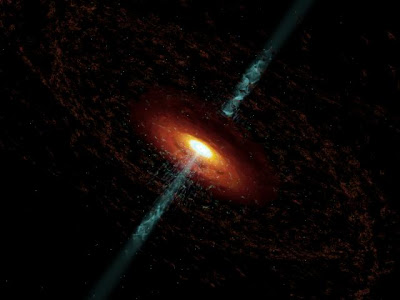
Michigan telescopes help give astronomers insights into blazars
Thursday, April 24, 2008
Galaxies Gone Wild!
 Credit: NASA, ESA,
Credit: NASA, ESA,the Hubble Heritage (STScI/AURA)-ESA/Hubble Collaboration,
and A. Evans (University of Virginia,
Charlottesville/NRAO/Stony Brook University)
But galaxies have a wild side. They have flirtatious close encounters that sometimes end in grand mergers and overflowing "maternity wards" of new star birth as the colliding galaxies morph into wondrous new shapes.
Today, in celebration of the Hubble Space Telescope's 18th launch anniversary, 59 views of colliding galaxies constitute the largest collection of Hubble images ever released to the public. This new Hubble atlas dramatically illustrates how galaxy collisions produce a remarkable variety of intricate structures in never-before-seen detail.
Astronomers observe only one out of a million galaxies in the nearby universe in the act of colliding. However, galaxy mergers were much more common long ago when they were closer together, because the expanding universe was smaller. Astronomers study how gravity choreographs their motions in the game of celestial bumper cars and try to observe them in action.
For all their violence, galactic smash-ups take place at a glacial rate by human standards - timescales on the order of several hundred million years. The images in the Hubble atlas capture snapshots of the various merging galaxies at various stages in their collision.
Most of the 59 new Hubble images are part of a large investigation of luminous and ultra- luminous infrared galaxies called the GOALS project (Great Observatories All-sky LIRG Survey). This survey combines observations from Hubble, NASA's Spitzer Space Telescope, NASA's Chandra X-ray Observatory, and NASA's Galaxy Evolution Explorer. The majority of the Hubble observations are led by Aaron S. Evans of the University of Virginia, Charlottesville, the National Radio Astronomy Observatory, and Stony Brook University.
For more information, contact:
Ray Villard
Space Telescope Science Institute, Baltimore, Md.
410-338-4514
villard@stsci.edu
Lars Lindberg Christensen
Hubble/ESA, Garching, Germany
011-49-89-3200-6306
lars@eso.org
Aaron Evans
University of Virginia, Charlottesville, Va.
ae3f@mail.astro.virginia.edu
Tuesday, April 22, 2008
Astrophotography: NGC 3718 by Dietmar Hagar
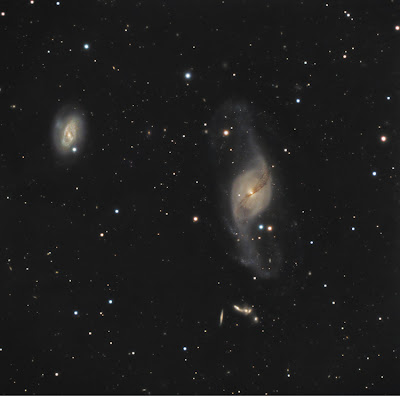
Originally discovered by Sir William Herschel during this very same month 211 years ago, NGC 3718 became the future study of an astronomer named Halton Arp. For 28 years Dr. Arp was staff astronomer at the Mt. Palomar and Mt. Wilson observatories and while there, he produced his well known catalog of Peculiar Galaxies that are disturbed or irregular in appearance. Needless to say, NGC 3718 became Arp 214: ""Barred spiral, (with a) sharp nucleus, narrow absorption lanes through center".
But it's not quiet and it's alone in the field. Joining warped NGC 3718 around 150,000 light years away is NGC 3729 - another massive galaxy which may be causing its neighbor's peculiarities. While the warping of galactic discs is common, the process is not quite yet understood. It's highly possible that tidal forces exerted by neighboring galaxies could be at work and in the case of this pair, it seems to carry through.
NGC 3718 contains an active galactic nucleus (AGN) and is known as a Seyfert Galaxy type 1.9 - one which may contain a massive black hole and is known for violent stars. Through HI mapping, NGC 3718 displays a tidal "tail" which begins on its eastern frontier and extends north towards its companion, NGC 3729. Is this just a case gravitational relationship? One galaxy consuming another? Let's find out…
It is commonly accepted that when galaxies pass each other that tidal forces draw out the companion galaxy's stars, gas, and dust in the formation of a spectacular tail. Just as it is commonly accepted that a merger of two spiral galaxies results in a remnant with an elliptical-like surface-brightness profile. In the case of NGC 3718, it would appear (according to interferometer data), the disk warp is evolving into a polar ring. No doubt, its molecular gas content is consistent with elliptical galaxy structure, but the distribution is warping the inner disk. At the same time, 2MASS data shows Arp 214's main support against gravitational collapse comes from pressure due to random motion of stars as seen in an elliptical galaxy rather than from rotation. The origin of the unusual combination of properties makes the whole scene not only beautiful to look at, but most unique.
But don't stop there… A closer examination of this picture will also show another another compact set of interacting galaxies as well - Hickson 56. Instead of two, there are five which share similarities with the closer cousins. Located some 400 million light years distant, this Hickson compact group has several catalogue designations including UGC 6527, VV 150, Markarian 176 and Arp 322 and were originally observed by Lord Rosse. According to Halton Arp, "Much print has been dedicated to explaining discordant redshifts in compact groups as unrelated background galaxies. But no one has analyzed the accordant galaxies. It is shown here that when there is a brightest galaxy in the group, the remainder with differences of less than 1000 km s−1 are systematically redshifted. This is the same result as obtained in all other well-defined groups and demonstrates again an increasing intrinsic redshift with fainter luminosity."
So what's Paul Hickson take? "Group 56 consists of five galaxies, three of which appear to be in contract and interacting. Two of these three galaxies (B and D) are stream of "galaxy stuff" linking its B and C components. An examination of the C galaxy reveals an asymmetric halo but D has a less complex outer luminosity profile. Last, but not least, both the A and D galaxies are Seyfert. More galaxies that have - or are - interacting in the past, present and future.
What's the chances of seeing some these galaxies yourself? Not bad at all. For the average-to-large telescope, NGC 3718 (RA 11 32 56 Dec +53 01 55) is roughly magnitude 10 to 11 (depending on whose scale you're looking at) and is noted as a soft, even haze with a dark dustlane seen upon aversion. NGC 3729 (RA 11 34 Dec +53 08), despite its magnitude billing is low surface brightness and requires a large telescope and aversion to detect. As for Hickson 56 (RA 11 32 46 Dec +52 56 28), you're going to need major aperture and excellent skies to even see a hint of this quintuplet.
Thanks to the photographic magic of Dietmar Hagar of Austria, we're able to enjoy this cosmic portrait. Using a 9" TMB refractor, the image was captured with a SXV H16 CCD camera and processed with AstroArt Software, Maxim DL and Registax. When Dietmar isn't busy being a trauma surgeon, he certainly takes outstanding astrophotos and is a member of the MRO imaging team. We thank him for sharing!
Written by Tammy Plotner
Wednesday, April 16, 2008
Hubble Finds that "Blue Blobs" in Space Are Orphaned Clusters of Stars
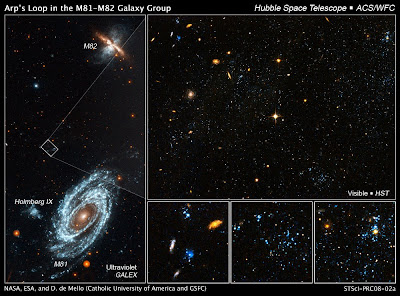 About this image: [Left] A GALEX ultraviolet image of the interacting galaxies M81 and M82, which lie 12 million light-years away in the constellation Ursa Major. The gravity from each galaxy dramatically affected the other during their last close encounter, 200 million years ago. Gas density waves rippling around M81 make it a grand design spiral. M82 is undergoing a starburst at its core, creating glowing fingers of hydrogen.
About this image: [Left] A GALEX ultraviolet image of the interacting galaxies M81 and M82, which lie 12 million light-years away in the constellation Ursa Major. The gravity from each galaxy dramatically affected the other during their last close encounter, 200 million years ago. Gas density waves rippling around M81 make it a grand design spiral. M82 is undergoing a starburst at its core, creating glowing fingers of hydrogen.Credit: NASA, ESA, and D. de Mello (Catholic University of America/GSFC)
The findings are being reported by Duilia de Mello of the Catholic University of America, Washington, D.C. and NASA's Goddard Space Flight Center, Greenbelt, Md. and her colleagues at the 211th meeting of the American Astronomical Society in Austin, Texas.
Such "blue blobs"-weighing tens of thousands of solar masses-have never been seen in detail before in such sparse locations, say researchers. They are more massive than most open clusters found inside galaxies but a fraction of the mass of globular star clusters that orbit a galaxy.
Because the orphan stars don't belong to any particular galaxy, the heavier elements produced in their fusion furnaces may easily be expelled back into intergalactic space. This may offer clues as to how the early universe was "polluted" with heavier elements early in its history, say researchers.
The mystery is that the "blue blobs" are found along a wispy bridge of gas strung among three colliding galaxies, M81, M82, and NGC 3077, residing approximately 12 million light-years from Earth. This is not the place astronomers expect to find star clusters: in the "abyssal plain" of intergalactic space. "We could not believe it, the stars were in the middle of nowhere," says de Mello.
The "blue blobs" are clumped together in a structure called Arp's Loop, along the tenuous gas bridge. The gas filaments were considered too thin to accumulate enough material to actually build these many stars, says de Mello. But Hubble reveals the "blue blobs" contain the equivalent of five Orion Nebulae.
After finding that these "blobs" were resolved into stars, the team used the Hubble image to measure an age for the clusters of less than 200 million years with many stars as young and even younger than 10 million years. Not coincidentally, 200 million years is the estimated age of the galactic collision that created the tidal gas streamers, pulled between the galaxies like taffy.
De Mello and her team propose that the star clusters in this diffuse structure might have formed from gas collisions and subsequent turbulence, which enhanced locally the density of the gas streams. Galaxy collisions were much more frequent in the early universe, so "blue blobs" should have been common. After the stars burned out or exploded, the heavier elements forged in their nuclear furnaces would have been ejected to enrich intergalactic space.
Radio observations with the Very Large Array of radio telescopes in Socorro, New Mexico, gave a detailed map of the intergalactic bridge that revealed knots of denser gas. Studies with the 3.5-meter WIYN telescope on Kitt Peak in Arizona mapped the optical light glow of hydrogen along the bridge. Observations with NASA's Galaxy Evolution Explorer (GALEX) ultraviolet space telescope revealed an ultraviolet glow at the knots, and that earned them the nickname "blue blobs." But GALEX did not have the resolution to see individual stars or clusters. Only Hubble's Advanced Camera for Surveys at last revealed the point sources of the ultraviolet radiation.
CONTACT
Ray Villard
Space Telescope Science Institute, Baltimore,
Md. 410-338-4514 villard@stsci.edu
Robert Naeye
Goddard Space Flight Center,
Greenbelt, Md. 301-286-4453 robert.p.naeye@nasa.gov
Duilia de Mello
The Catholic University of America, Washington,
D.C. and Goddard Space Flight Center, Greenbelt, Md.
Tuesday, April 15, 2008
Milky Way's giant black hole awoke from slumber 300 years ago
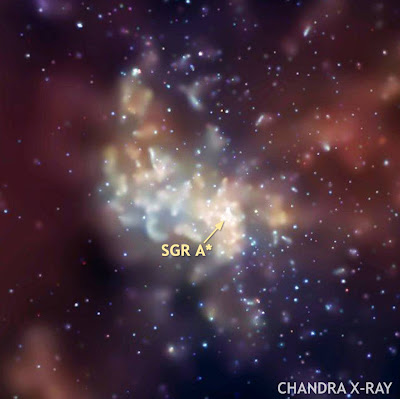 This Chandra image shows our galaxy’s centre. The location of the black hole, known as Sagittarius A*, or Sgr A* for short, is arrowed.
This Chandra image shows our galaxy’s centre. The location of the black hole, known as Sagittarius A*, or Sgr A* for short, is arrowed.A team of Japanese astronomers using ESA’s XMM-Newton, along with NASA and Japanese X-ray satellites, has discovered that our galaxy’s central black hole let loose a powerful flare three centuries ago.
The finding helps resolve a long-standing mystery: why is the Milky Way’s black hole so quiescent? The black hole, known as Sagittarius A-star (A*), is a certified monster, containing about 4 million times the mass of our Sun. Yet the energy radiated from its surroundings is thousands of millions of times weaker than the radiation emitted from central black holes in other galaxies.
"We have wondered why the Milky Way’s black hole appears to be a slumbering giant," says team leader Tatsuya Inui of Kyoto University in Japan. "But now we realise that the black hole was far more active in the past. Perhaps it’s just resting after a major outburst."
The observations, collected between 1994 and 2005, revealed that clouds of gas near the central black hole brightened and faded quickly in X-ray light as they responded to X-ray pulses emanating from just outside the black hole. When gas spirals inward toward the black hole, it heats up to millions of degrees and emits X-rays. As more matter piles up near the black hole, the X-ray output becomes greater.
Credits: ASCA and Suzaku: JAXA. Chandra: NASA/CXC. XMM-Newton: ESA
These X-ray pulses take 300 years to traverse the distance between the central black hole and a large cloud known as Sagittarius B2, so the cloud responds to events that occurred 300 years earlier.
Amazingly, a region in Sagittarius B2 only 10 light-years across, varied considerably in brightness in just 5 years. These brightenings are known as light echoes. By resolving the X-ray spectral line from iron, Suzaku’s observations were crucial for eliminating the possibility that subatomic particles caused the light echoes.
"By observing how this cloud lit up and faded over 10 years, we could trace back the black hole’s activity 300 years ago," says team member Katsuji Koyama of Kyoto University. "The black hole was a million times brighter three centuries ago. It must have unleashed an incredibly powerful flare."
This new study builds upon research by several groups who pioneered the light-echo technique. Last year, a team led by Michael Muno, who now works at the California Institute of Technology in, California, USA, used Chandra observations of X-ray light echoes to show that Sagittarius A* generated a powerful burst of X-rays about 50 years ago — about a dozen years before astronomers had satellites that could detect X-rays from outer space. "The outburst three centuries ago was 10 times brighter than the one we detected," says Muno.
The galactic centre is about 26 000 light-years from Earth, meaning we see events as they occurred 26 000 years ago. Astronomers still lack a detailed understanding of why Sagittarius A* varies so much in its activity. One possibility, says Koyama, is that a supernova a few centuries ago plowed-up gas and swept it into the black hole, leading to a temporary feeding frenzy that awoke the black hole from its slumber and produced the giant flare.
Notes for editors:
The new study, which will appear in the Publications of the Astronomical Society of Japan, combines results from Japan’s Suzaku and ASCA X-ray satellites, NASA’s Chandra X-ray Observatory, and the ESA’s XMM-Newton X-ray Observatory. The article in which the results appear is titled ‘ Time Variability of the Neutral Iron Lines from the Sgr B2 Region and its Implication of a Past Outburst of Sgr A*’ by T. Inui, K. Koyama, H. Matsumoto and T. Tsuru
Launched in 2005, Suzaku is the fifth in a series of Japanese satellites devoted to studying celestial X-ray sources and is managed by the Japan Aerospace Exploration Agency (JAXA). This mission is a collaborative effort between Japanese universities and institutions and NASA Goddard.
XMM-Newton, ESA’s space-borne X-ray observatory is the biggest scientific satellite ever built in Europe. Its telescope mirrors are the most sensitive ever developed in the world, and with its sensitive detectors, it sees much more than any previous X-ray satellite.
XMM-Newton science operations are handled at ESA’s European Space and Astronomy Centre (ESAC). The satellite was designed and built to return data for at least a decade. It has detected more X-ray sources than any previous satellite and is helping solve many cosmic mysteries of the violent Universe, from what happens in and around black holes to the formation of galaxies in the early Universe. The satellite uses over 170 wafer-thin cylindrical mirrors spread over three telescopes.
Its orbit takes it almost a third of the way to the Moon, so that astronomers can enjoy long, uninterrupted views of celestial objects. NASA's Marshall Space Flight Center, Alabama, USA manages the Chandra program for the agency's Science Mission Directorate. The Smithsonian Astrophysical Observatory controls science and flight operations from the Chandra X-ray Center in Massachusetts, USA.
 An assembly of 51 mirrors, carefully sized, formed and nested one inside another, makes XMM-Newton the most sensitive X-ray telescope ever built. ESA's XMM-Newton derives its name from its X-ray multi-mirror design and honours Sir Isaac Newton. This unique X-ray observatory was launched by Ariane 5 from the European spaceport in French Guiana on 10 December 1999. Credit: ESA
An assembly of 51 mirrors, carefully sized, formed and nested one inside another, makes XMM-Newton the most sensitive X-ray telescope ever built. ESA's XMM-Newton derives its name from its X-ray multi-mirror design and honours Sir Isaac Newton. This unique X-ray observatory was launched by Ariane 5 from the European spaceport in French Guiana on 10 December 1999. Credit: ESAThe Drifting Star
 ESO PR Photo 09b/08
ESO PR Photo 09b/08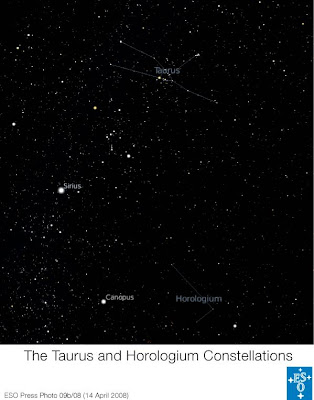
Astronomers 'listen' to an exoplanet-host star and find its birthplace
Previously, astronomers using an ESO telescope had shown that the star harbours a planet, more than 2 times as large as Jupiter and orbiting in 320 days (ESO 12/99).
But until now, all studies were unable to pinpoint the exact characteristics of the star, and hence to understand its origin. A team of astronomers, led by Sylvie Vauclair from the University of Toulouse, France, therefore decided to use the technique of 'asteroseismology' to unlock the star's secrets.
"In the same way as geologists monitor how seismic waves generated by earthquakes propagate through the Earth and learn about the inner structure of our planet, it is possible to study sound waves running through a star, which forms a sort of large, spherical bell," says Vauclair.
The 'ringing' from this giant musical instrument provides astronomers with plenty of information about the physical conditions in the star's interior.
And to 'listen to the music', the astronomers used one of the best instruments available. The observations were conducted in November 2006 during 8 consecutive nights with the state-of-the-art HARPS spectrograph mounted on the ESO 3.6-m telescope at La Silla.
Up to 25 'notes' could be identified in the unique dataset, most of them corresponding to waves having a period of about 6.5 minutes.
These observations allowed the astronomers to obtain a very precise portrait of Iota Horologii: its temperature is 6150 K, its mass is 1.25 times that of the Sun, and its age is 625 million years. Moreover, the star is found to be more metal-rich than the Sun by about 50%.
"These results show the power of asteroseismology when using a very precise instrument such as HARPS," says Vauclair. "It also shows that Iota Horologii has the same metal abundance and age as the Hyades cluster and this cannot be a coincidence."
The Hyades is an ensemble of stars that is seen with the unaided eye in the Northern constellation Taurus ("The Bull"). This open cluster, located 151 light-years away, contains stars that were formed together 625 million years ago.
The star Iota Horologii must have thus formed together with the stars of the Hyades cluster but must have slowly drifted away, being presently more than 130 light-years away from its original birthplace. This is an important result to understand how stars move on the galactic highways of the Milky Way.
This also means that the amount of metals present in the star is due to the original cloud from which it formed and not because it engulfed planetary material. "The chicken and egg question of whether the star got planets because it is metal-rich, or whether it is metal-rich because it made planets that were swallowed up is at least answered in one case," says Vauclair.
More information
The astronomers' study is being published as a Letter to the Editor in Astronomy and Astrophysics ("The exoplanet-host star iota Horologii: an evaporated member of the primordial Hyades cluster", by S. Vauclair et al.). The team is composed of Sylvie Vauclair, Marion Laymand, Gérard Vauclair, Alain Hui Bon Hoa, and Stéphane Charpinet (LATT, Toulouse, France), François Bouchy (IAP, Paris, France), and Michaël Bazot (University of Porto, Portugal).
Science Contacts
Sunday, April 13, 2008
Coldest Brown Dwarf Ever Observed: Closing The Gap Between Stars And Planets
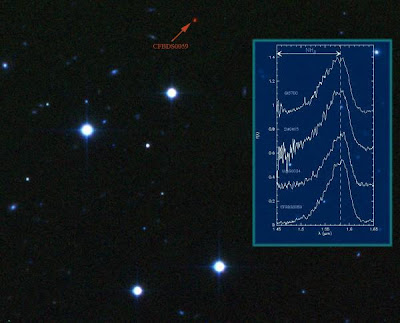 Picture of the brown dwarf CFBDS0059 (small red dot on the top of the picture) and its near-infrared spectrum (lowest curve) illustrating the presence of ammonia.
Picture of the brown dwarf CFBDS0059 (small red dot on the top of the picture) and its near-infrared spectrum (lowest curve) illustrating the presence of ammonia.An international team [1] led by French and Canadian astronomers has just discovered the coldest brown dwarf ever observed. Their results will soon be published in Astronomy & Astrophysics. This new finding was made possible by the performance of telescopes worldwide [2]: Canada France Hawaii Telescope (CFHT) and Gemini North Telescope, both located in Hawaii, and the ESO/NTT located in Chile.
The brown dwarf is named CFBDS J005910.83-011401.3 (it will be called CFBDS0059 in the following). Its temperature is about 350°C and its mass about 15-30 times the mass of Jupiter, the largest planet of our solar system [3]. Located about 40 light years from our solar system, it is an isolated object, meaning that it doesn't orbit another star.
Brown dwarfs are intermediate bodies between stars and giant planets (like Jupiter). The mass of brown dwarfs is usually less than 70 Jupiter masses. Because of their low mass, their central temperature is not high enough to maintain thermonuclear fusion reactions over a long time. In contrast to a star like our Sun, which spends most of its lifetime burning hydrogen, hence keeping a constant internal temperature, a brown dwarf spends its lifetime getting colder and colder after its formation.
The first brown dwarfs were detected in 1995. Since then, this type of stellar object has been found to share common properties with giant planets, even though differences remain. For example, clouds of dust and aerosols, as well as large amounts of methane, were detected in their atmosphere (for the coldest ones), just as in the atmosphere of Jupiter and Saturn. However, there were still two major differences. In the brown dwarf atmospheres, water is always in gaseous state, while it condenses into water ice in giant planets; and ammonia has never been detected in the brown dwarf near-infrared spectra, while it is a major component of Jupiter's atmosphere. CFBDS0059, the newly-discovered brown dwarf, looks much more like a giant planet than the known classes of brown dwarfs, both because of its low temperature and because of the presence of ammonia.
To date, two classes of brown dwarfs have been known: the L dwarfs (temperature of 1200-2000°C), which have clouds of dust and aerosols in their high atmosphere; and the T dwarfs (temperature lower than 1200°C), which have a very different spectrum because of methane forming in their atmospheres. Because it contains ammonia and has a much lower temperature than do L and T dwarfs, CFBDS0059 might be the prototype of a new class of brown dwarfs to be called the Y dwarfs. This new class would then become the missing link in the sequence from the hottest stars to giant planets of less than -100°C, by filling the gap now left in the midrange.
This discovery also has important implications in the study of extrasolar planets. The atmosphere of brown dwarfs looks very much like that of giant planets, therefore the same models are used to reproduce their physical conditions. Such modeling needs to be tested against observations. Observing the atmospheres of extrasolar planets is indeed very hard because the light from the planets is embedded in the much stronger light from their parent stars. Because brown dwarfs are isolated bodies, they are much easier to observe. Thus, looking to brown dwarfs with a temperature close to that of the giant planets will help in testing the models of extrasolar planets' atmospheres.
Notes:
[1] The team of astronomers includes P. Delorme, X. Delfosse (Observatoire de Grenoble, France), L. Albert (CFHT, Hawaii), E. Artigau (Gemini Observatory, Chile), T. Forveille (Obs. Grenoble/France, IfA/Hawaii), C. Reylé (Observatoire de Besançon, France), F. Allard, A. C. Robin (CRAL, Lyon, France), D. Homeier (Göttingen, Germany), C.J. Willott (University of Ottawa, Canada), M. C. Liu, T. J. Dupuy (IfA, Hawaii).
[2] CFBDS0059 was discovered in the framework of the Canada-France Brown-Dwarfs survey. The object was first identified in pictures from the wide-field camera Megacam installed on the CFHT (Canada France Hawaii Telescope). Infrared pictures were then obtained with the NTT telescope (La Silla, ESO, Chile) and confirmed the low temperature of the object. Finally, the spectrum showing the presence of ammonia was obtained using the Gemini North Telescope (Hawaii).
[3] The mass of Jupiter is about 300 times the Earth's mass and about 1/1000e of the Sun's mass.
Reference: CFBDS J005910.90-011401.3: reaching the T-Y brown dwarf transition? by P. Delorme, X. Delfosse, L. Albert, E. Artigau, T. Forveille, C. Reylé, F. Allard, D. Homeier, A. C. Robin, C.J. Willott, M. C. Liu, and T. J. Dupuy. Astronomy & Astrophysics, 2007, 473, p. 511. Full article available in PDF format.
Stars burst into life in the early Universe
The strongest burst of star formation in the history of the Universe occurred about two billion years after the Big Bang, say astronomers presenting their research at the National Astronomy Meeting this week.
The international team of astronomers from the UK, France, Germany and the USA found evidence for a massive surge in star birth in a newly discovered population of massive galaxies in the early Universe. Dr Scott Chapman, from the Institute of Astronomy at Cambridge, reveals that five of the galaxies are forming stars at a tremendous rate and have large reservoirs of gas that will power the star formation for hundreds of millions of years.
The galaxies are so distant that the light we detect from them has been travelling for more than 10 billion years, meaning that we see them as they were about three billion years after the Big Bang. The recent discovery of a new type of luminous galaxy in this epoch - one that is very faint in visible light but much brighter at longer radio wavelengths - is pivotal to the new results.
A related type of galaxy was found over ten years ago using the SCUBA camera on the James Clerk Maxwell Telescope in Hawaii that detects radiation emitted at sub-millimetre wavelengths, which are longer than the wavelengths of visible light and shorter than radio waves. The SCUBA camera is biased towards cooler objects so the Cambridge-led team of astronomers concluded that these distant "submillimetre galaxies" might only represent half the picture of rapid star formation. The team proposed that a population of similar galaxies with slightly hotter temperatures could exist but had previously gone unnoticed.
Using observatories around the world, including MERLIN in the UK, the Very Large Array in the US, the Keck telescope in Hawaii and the Plateau de Bure submillimetre observatory in France, the new research team implemented a missing galaxy search, and were rewarded with the location of the galaxies exhibiting unprecedented rates of star formation, which were confirmed by the detection of vastly extended gas and dust regions around the galaxies. The researchers commented that these galaxies probably formed after the first stars and galaxies had already formed in what would have been a perfectly smooth Universe.
The new results offer a window into the earliest epochs of star formation after the Big Bang and have provided astronomers with a much more detailed census of the most active galaxies in the young Universe. Future observations will investigate further the details of the galaxies' power source and try to establish how they will develop once their intense bursts of activity come to an end.
Badly behaved spinning stars make astronomers dizzy
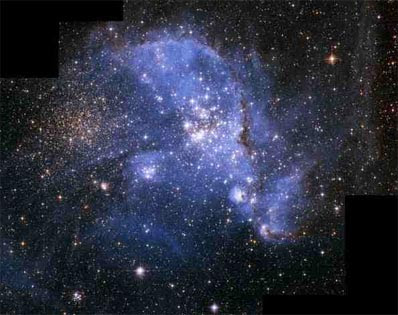 Spinning stars in the Small Magellenic Cloud with the wrong levels of mixing are challenging astronomers theories about massive stars.
Spinning stars in the Small Magellenic Cloud with the wrong levels of mixing are challenging astronomers theories about massive stars. Credit: A. Nota (ESA/STScI) et al., ESA, NASA.
Massive stars rotate very quickly, although nobody is sure why. Because massive stars only exist for a few dozen years before exploding as supernovae, compared to billions of years for lower mass stars like the Sun, astronomers do not know whether the fast rotation is down to their mass or whether it is down to their young age.
Regardless, the fast rotation creates powerful, spinning currents inside the massive stars that churns up the gases within them, a process termed 'mixing'.
However, the new study conducted by astronomers at Queen's University have found that this is not necessarily the case.
Spending 112 hours in total using the FLAMES multi-object spectrograph on the Very Large Telescope, which can measure spectra from 132 different objects simultaneously, they targeted 800 massive stars found in star clusters in the Large and Small Magellanic Clouds, and the Milky Way. To measure the amount of mixing, they studied the amount of churned up nitrogen that had made its way to the surfaces of these stars.
The clusters were divided up into ages of one to five million years, and 10 to 15 million years, to compare the different stages of their evolution. But they found that 20 percent of the stars were relatively slow rotators yet had an overabundance of nitrogen at their surfaces, whereas another 20 percent were fast rotators but had less nitrogen amongst their surface composition.
Additionally, they found that stars in the Small Magellanic Cloud span faster than their counterparts in the Milky Way that have a similar composition.
The remaining sixty percent appeared to fit previously established models, but the badly behaving forty percent suggest that other factors other than spin rate are at work in the mixing of material inside a massive star, which could affect how they evolve in terms of their lifetimes and specific type of supernova when they die.
ASTRONOMY NOW
DG Tau - Energetic Jets from a Budding Solar System
The image on the left from NASA's Chandra X-ray Observatory shows the first double-sided X-ray jet ever detected from a young star. A similar jet may have been launched from the young Sun and could have had a significant impact on the early solar system.
The young star, named DG Tau, is located in the Taurus star-forming region, about 450 light years from Earth. The bright source of X-rays in the middle of the image is DG Tau and the jet runs from the top left to the bottom right, extending to about 70 billion miles away from the star, or about 700 times the Earth-Sun separation.
A detailed analysis of this image, led by Manuel Guedel of the Institute of Astronomy, ETH Zuerich in Switzerland, shows that the counter jet (top-left) has, on average, higher energy X-rays than the forward jet (bottom-right). The likely explanation is that some of the lower energy X-rays in the counter jet are absorbed by a disk around DG Tau, as shown in the accompanying illustration (right graphic), showing the star, disk and the inner regions of the jets.
Highly energetic X-rays are also detected from the young star, partially absorbed by streams of material flowing from the disk onto the star. The disk itself is much too cool to be detected by Chandra. Note that the faint vertical feature below the star does not show evidence for an additional jet, but is a chance alignment of four photons.
The effects of the jet on its surroundings may be significant. Other researchers have previously suggested that X-rays from a typical young star can significantly affect the properties of its surrounding disk, by heating it and creating charged particles by stripping electrons off atoms (a process called ionization). These X-rays will strike the disk at a low angle, mitigating their effects. In the case of the jets from DG Tau, the combined X-ray power in the jet is similar to that of a young star with relatively modest X-ray brightness, but X-rays from the jet have the advantage of striking the disk much more directly from above and below.
Guedel and colleagues argue that powerful X-ray jets might develop at some stage during the evolution of most young stars. They could, for example, have existed during the early stages of the solar system. DG Tau has about the same mass as the Sun, but is much younger with an age of about one million years, rather than about 4.5 billion years. Since it is surrounded by a disk where planets may be forming, this new Chandra image suggests that the early Earth and its environment may have been bathed in X-rays from a jet like DG Tau's. Although it is unknown if such X-rays would have had a significant impact on the forming Earth, it is possible that they did more good than harm. By ionizing the disk the X-rays may have generated turbulence, which could have had a substantial effect on the orbit of the young Earth, possibly helping to prevent it from making a disastrous plunge into the Sun. Furthermore, X-ray irradiation of disks may also be important in the production of complex molecules in the disk that will later end up on the forming planets.
The new X-ray observations of X-ray jets add new features to the already complex story of star and planet formation. The ionization and heating power of the X-rays rom jets will have to be included in future model calculations that will help scientists understand the physical evolution and chemical processing of environments that eventually lead to planets like those in our solar system.
Friday, April 11, 2008
Witnessing the formation of distant galaxies
 Zooming into a small fraction of the UKIDSS UDS field, the deepest infrared image ever obtained over such a large area. The zoom shows a relatively nearby spiral galaxy. Many of the faint red objects in the background are massive galaxies at distances of over 10 billion light-years. Credit:JAC/UKIRT
Zooming into a small fraction of the UKIDSS UDS field, the deepest infrared image ever obtained over such a large area. The zoom shows a relatively nearby spiral galaxy. Many of the faint red objects in the background are massive galaxies at distances of over 10 billion light-years. Credit:JAC/UKIRTAstronomers have produced an image containing more than 100,000 galaxies.
Provided by the Joint Astronomy Centre
Due to the finite speed of light, these observations allow astronomers to look back in time over 10 billion years, producing images of galaxies in the universe's infancy. The image is so large and so deep that thousands of galaxies can be studied at these early epochs for the first time. By observing in the infrared, astronomers can now peer further back in time, since light from the most distant galaxies is shifted towards redder wavelengths as it travels through the expanding universe.
"I would compare these observations to the ice cores drilled deep into the Antarctic," says Foucaud. "Just as they allow us to peer back in time, our ultra-deep image allows us to look back and observe galaxies evolving at different stages in cosmic history, all the way back to just 1 billion years after the Big Bang".
One of the key aims is to understand when the rarest, most massive galaxies form in the distant universe, which is a long-standing unsolved problem in astronomy. "We see galaxies 10 times the mass of the Milky Way already in place at very early epochs. Now, for the first time, we are sampling a large enough volume of the distant universe to be able to see them in sufficient numbers and really pin down when they were formed."
The image was obtained using the United Kingdom Infrared Telescope (UKIRT) in Hawaii. The results presented today form part of the Ultra-Deep Survey (UDS), led by Omar Almaini at the University of Nottingham. The UDS is one element of a five-part project, the UKIRT Infrared Deep Sky Survey, which commenced in 2005. Professor Andy Lawrence, Principal Investigator of UKIDSS from the University of Edinburgh, says "As we keep taking images over the next few years, we will see ever more distant galaxies."
Close encounters of three black holes
Manuela Campanelli, Carlos Lousto and Yosef Zlochower — scientists in Rochester Institute of Technology's Center for Computational Relativity and Gravitation — simulated triplet black holes to test their breakthrough method that, in 2005, merged two of these large mass objects on a supercomputer following Einstein's theory of general relativity.
The new simulation of multiple black holes evolving, orbiting and eventually colliding confirmed a robust computer code free of limitations. The May issue of Physical Review D will publish the team's latest findings, revealing the distinct gravitational signature three black holes might produce.
"We discovered rich dynamics leading to very elliptical orbits, complicated orbital dynamics, simultaneous triple mergers and complex gravitational waveforms that might be observed by gravitational wave detectors such as LIGO and LISA," says Lousto, professor in RIT's School of Mathematical Sciences. "These simulations are timely because a triple quasar was recently discovered by a team led by Caltech astronomer George Djorgovski. This presumably represents the first observed supermassive black hole triplet."
The RIT team's triple merger simulates the simplest case of equal masses and non-spinning black holes, a prerequisite for exploring configurations of unequal masses and different spins and rotations. The center's supercomputer cluster "newHorizons" processed the simulations and performed evolutions of up to 22 black holes to verify the results.
"Twenty-two is not going to happen in reality, but three or four can happen," says Yosef Zlochower, an assistant professor in the School of Mathematical Sciences. "We realized that the code itself really didn't care how many black holes there were. As long as we could specify where they were located-and had enough computer power-we could track them."
Specially designed high-performance computers like newHorizons are essential tools for scientists like Campanelli's team who specialize in computational astrophysics and numerical relativity, a research field dedicated to proving Einstein's theory of general relativity. Only supercomputers can simulate the force of impact necessary to generate gravity waves-warps in space-time that might provide clues to the origin of the universe.
Scientists expect to measure actual gravity waves for the first time within the next decade using the ground-based detector known as the Laser Interferometer Gravitational Wave Observatory (LIGO) and the future NASA/European Space Agency space mission Laser Interferometer Space Antenna (LISA).
"In order to confirm the detection of gravitational waves, scientists need the modeling of gravitational waves coming from space," says Campanelli, director of RIT's Center for Computational Relativity and Gravitation. "They need to know what to look for in the data they acquire otherwise it will look like just noise. If you know what to look for you can confirm the existence of gravitational waves. That's why they need all these theoretical predictions."
Adds Lousto, "Gravity waves can also confirm the existence of black holes directly because they have a special signature. That's what we're simulating. We are predicting a very specific signature of black hole encounters. And so, if we check that, there's a very strong evidence of existence of black holes."
Missing Link Between Planets and Stars Found
Credit: Robert Roy Britt, SPACE.com.
The failed star might represent a new class of objects that are a missing link between planets and stars.
The cold brown dwarf floats freely in space, not bound to a star. Its mass is somewhere between 15 and 30 times that of Jupiter. And it is about 660 degrees Fahrenheit (350 Celsius), cooler than any other known object in its class.
The surface of the sun is about 11,000 degrees F (6,000 degrees C). The temperature at the top of Jupiter's clouds is about -230 degrees F (-145 degrees C), though at its core the mercury soars to 43,000 degrees F (24,000 degrees C).
The brown dwarf, named CFBDS J005910.83-011401.3, is about 40 light-years from our solar system. It was found by an international team using the Canada-France-Hawaii Telescope and Gemini North Telescope, both located in Hawaii, and the a European Southern Observatory telescope in Chile.
Oddballs
The mass of brown dwarfs is usually less than 70 Jupiter masses. In contrast to a star like our sun, which spends most of its lifetime burning hydrogen and keeping a constant internal temperature, a brown dwarf spends its lifetime getting colder and colder.
The first brown dwarfs were detected in 1995. Since then, they have been found to share common properties with giant planets, while differences remain. For example, clouds of dust and aerosols, as well as large amounts of methane, were detected in the atmospheres of the coolest brown dwarfs, just as in the atmosphere of Jupiter and Saturn.
However, there were still two major differences. In the brown dwarf atmospheres, water is always in gaseous state, while it condenses into water ice in giant planets; and ammonia has never been detected in the brown dwarf, while it is a major component from Jupiter's atmosphere.
Cooler still
The newly-discovered brown dwarf looks much more like a giant planet than the known classes of brown dwarfs, both because of its low temperature and because of the presence of ammonia.
To date, two classes of brown dwarfs have been known: the L dwarfs (temperature of 2,100 to 3,600 Fahrenheit (1,200-2,000 C), which have clouds of dust and aerosols in their high atmosphere, and the T dwarfs (temperature lower than 2,100 F), which have a very different spectrum because of methane forming in their atmosphere.
Because it contains ammonia and has a much lower temperature than do L and T dwarfs, CFBDS0059 might be the protoype of a new class of brown dwarfs to be called the Y dwarfs, the researchers propose. This new class would become the coldest stellar objects, hence the missing link toward giant planets.
Almost a planet
This discovery also has important implications in the study of extrasolar planets.
The atmosphere of brown dwarfs looks very much like that of giant planets, therefore the same models are used to reproduce their physical conditions. Such modeling requires to be constrained with observations. Observing the atmospheres of extrasolar planets is indeed very hard because the light from the planets is embedded in the much stronger light from their parent star. Because brown dwarfs are sometimes isolated bodies, with no stars nearby, they are much easier to observe.
So looking to brown dwarfs with a temperature close to that of the giant planets will help in constraining the models of extrasolar planets' atmospheres, the researchers said.
The discovery, led by researchers at Observatoire de Grenoble in France, the Canada-France-Hawaii Telescope, the University of Ottawa and other institutions will be detailed in the journal Astronomy & Astrophysics.
Thursday, April 10, 2008
Hubble Pinpoints Record-Breaking Explosion
Peering across 7.5 billion light-years and halfway back to the Big Bang, NASA's Hubble Space Telescope has photographed the fading optical counterpart of a powerful gamma ray burst that holds the record for being the intrinsically brightest naked-eye object ever seen from Earth.
For nearly a minute this single star was as bright as 10 million galaxies. Hubble Wide Field and Planetary Camera 2 (WFPC2) images of GRB 080319B, taken on Monday, April 7, show the fading optical counterpart of the titanic blast. The object erupted in a brilliant flash of gamma rays and other electromagnetic radiation at 2:12 a.m.
EDT on March 19, and was detected by Swift, NASA's gamma ray burst watchdog satellite. Immediately after the explosion, the gamma ray burst glowed as a dim 5th magnitude "star" in the spring constellation Bootes.
Designated GRB 080319B, the intergalactic firework has been fading away ever since then. Hubble astronomers had hoped to see the host galaxy where the burst presumably originated, but were taken aback that the light from the GRB is still drowning out the galaxy's light even three weeks after the explosion. This is particularly surprising because it was such a bright GRB initially. Previously, bright bursts have tended to fade more rapidly, which fits in to the theory that brighter GRBs emit their energy in a more tightly confined beam.
The slow fading leaves astronomers puzzling about just where the energy came from to power this GRB, and makes Hubble's next observations of this object in May all the more crucial. Called a long-duration gamma ray burst, such events are theorized to be caused by the death of a very massive star, perhaps weighing as much as 50 times our Sun.
Such explosions, sometimes dubbed "hypernovae," are more powerful than ordinary supernova explosions and are far more luminous, in part because their energy seems to be concentrated into a blowtorch-like beam that, in this case, was aimed directly at Earth.
The Hubble exposure also shows field galaxies around the fading optical component of the gamma ray burst, which are probably unrelated to the burst itself.
For more information, contact:
Ray Villard
Space Telescope Science Institute, Baltimore, Md.
410-338-4514
villard@stsci.edu
Nial Tanvir
University of Leicester
011-44-116-223-1217
nrt3@star.le.ac.uk
Andy Fruchter
Space Telescope Science Institute, Baltimore, Md.
410-338-5018
fruchter@stsci.edu
Wednesday, April 09, 2008
NASA Spacecraft Images Mars Moon in Color and in 3D
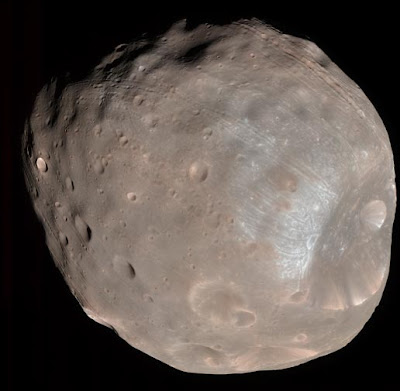 The High Resolution Imaging Science Experiment (HiRISE) camera on NASA's Mars Reconnaissance Orbiter took two images of the larger of Mars' two moons, Phobos, within 10 minutes of each other on March 23, 2008. This is the first, taken from a distance of about 6,800 kilometers (about 4,200 miles). It is presented in color by combining data from the camera's blue-green, red, and near-infrared channels.
The High Resolution Imaging Science Experiment (HiRISE) camera on NASA's Mars Reconnaissance Orbiter took two images of the larger of Mars' two moons, Phobos, within 10 minutes of each other on March 23, 2008. This is the first, taken from a distance of about 6,800 kilometers (about 4,200 miles). It is presented in color by combining data from the camera's blue-green, red, and near-infrared channels. This is the second image of Phobos, taken from a distance of about 5,800 kilometers (about 3,600 miles). It is presented in color by combining data from the camera's blue-green, red, and near-infrared channels.
This is the second image of Phobos, taken from a distance of about 5,800 kilometers (about 3,600 miles). It is presented in color by combining data from the camera's blue-green, red, and near-infrared channels.The High Resolution Imaging Science Experiment (HiRISE) on NASA's Mars Reconnaissance Orbiter took two images of Phobos 10 minutes apart on March 23. Scientists combined the images for a stereo view.
"Phobos is of great interest because it may be rich in water ice and carbon-rich materials," said Alfred McEwen, HiRISE principal investigator at the Lunar and Planetary Laboratory at the University of Arizona, Tucson.
Previous spacecraft, notably Mars Global Surveyor, have taken higher-resolution pictures of Phobos because they flew closer to the moon, said Nathan Bridges, HiRISE team member at NASA's Jet Propulsion Laboratory in Pasadena, Calif.
"But the HiRISE images are higher quality, making the new data some of the best ever for Phobos," said Bridges. "The new images will help constrain the origin and evolution of this moon."
By combining information from the camera's blue-green, red and near-infrared color filters, scientists confirmed that material around the rim of Phobos' largest surface feature, Stickney crater, appears bluer than the rest of Phobos. The impact that excavated the 9-kilometer (about 5.5 mile) in diameter Stickney crater is thought to have almost shattered the moon.
"Based on analogy with material on our own moon, the bluer color could mean that the material is fresher, or hasn't been exposed to space as long as the rest of Phobos' surface has," Bridges said.
The new view shows landslides along the walls of Stickney and other large craters: Phobos' striking surface grooves and crater chains; and craters hidden on the moon's dark side illuminated by "Marsshine."
"Marsshine" is sunlight reflected by Mars onto the moon. The phenomenon is similar to "Earthshine," where Earth reflects sunlight that illuminates the dark side of our moon. Like Earth's moon, Mars' moons Phobos and Deimos are "tidally locked" on their planet, that is, they always present the same side to the planet they orbit.
These images are among several new HiRISE images being released today at: http://www.nasa.gov/mission_pages/MRO/multimedia/20080409.html. The images include an anaglyph, or 3D view of Phobos that can be viewed with red-blue glasses.
The Mars Reconnaissance Orbiter flies at about 4,800 kilometers per hour (7,800 mph) between 250 to 316 kilometers (155 and 196 miles) above the surface of Mars.
Phobos was 6,800 kilometers (4,200 miles) away when the HiRISE camera took the first photograph. At that distance, the camera was able to resolve the surface at a scale of 6.8 meters (about 22 feet) per pixel, and see features as small as 20 meters (65 feet) across.
Phobos was 5,800 kilometers (3,600 miles) away when the HiRISE camera took the second picture minutes later. At that distance, the camera was able to resolve features about 15 meters (50 feet) across.
Phobos, only about 22 kilometers (13.5 miles) in diameter, has less than one-thousandth the gravity of Earth. That's not enough gravity to pull the moon into a sphere, so it's oblong. Mars' second moon, Deimos, is even smaller, at about 12 kilometers (7.5 miles) across. The very dark, diminutive moons may be captured asteroids from the outer, carbon-rich, Mars-Jupiter asteroid belt.
The Mars Reconnaissance Orbiter's Compact Reconnaissance Imaging Spectrometer for Mars, observed both Martian moons last year. By combining the data with HiRISE data on Phobos, scientists can map minerals and soil types on the moons.
Information about the Mars Reconnaissance Orbiter spacecraft is online at http://www.nasa.gov/mro.
The Mars Reconnaissance Orbiter mission is managed by JPL for NASA's Science Mission Directorate, Washington. Lockheed Martin Space Systems, Denver, Colo., is the prime contractor for the project and built the spacecraft. The University of Arizona operates the High Resolution Imaging Science Experiment camera, which was built by Ball Aerospace & Technologies Corp., Boulder, Colo.
Jet Propulsion Laboratory, Pasadena, Calif.
guy.webster@jpl.nasa.gov
Lori Stiles 520-626-4402
University of Arizona, Tucson
lstiles@u.arizona.edu






